If you're dealing with frequent heartburn, a sour taste in your mouth, or that burning feeling that climbs up your chest after eating, you're not alone. About 20% of people in the U.S. have gastroesophageal reflux disease, or GERD. It’s not just occasional discomfort-it’s a chronic condition where stomach acid regularly flows back into your esophagus, irritating the lining and sometimes leading to serious complications like Barrett’s esophagus or even esophageal cancer over time. The good news? Most people can get their symptoms under control without surgery. It starts with simple, proven changes to what you eat, how you live, and when you take your meds.
Start with Your Lifestyle-It’s the First Line of Defense
Before you reach for a pill, the most effective step is changing how you live. Studies show that 70% of people see major improvement just by adjusting their daily habits. It’s not about perfection-it’s about consistency.One of the easiest fixes? Elevate the head of your bed by six inches. This isn’t just propping up with pillows-that won’t work. Use blocks under the bed legs or a wedge pillow designed for GERD. Lying flat lets acid flow back easily. Raising your upper body helps gravity keep it where it belongs.
Timing matters too. Don’t lie down within three hours after eating. If you eat dinner at 7 p.m., wait until at least 10 p.m. before getting into bed. People who lie down within an hour of eating are 50% more likely to have nighttime reflux.
Weight plays a huge role. If you’re overweight, losing just 10% of your body weight can cut your symptoms by 40%. That’s not a miracle-it’s physics. Extra belly fat presses on your stomach, forcing acid upward. Even modest weight loss makes a measurable difference.
Smoking and alcohol are two big offenders. Smoking lowers the pressure in your lower esophageal sphincter (LES)-the muscle that acts like a gate between your stomach and esophagus. Within 20 minutes of a cigarette, that gate weakens by 30-40%. Alcohol does the same thing. Limit yourself to less than two drinks a day. One glass of wine might be fine. Two? That’s when reflux spikes.
What You Eat Can Make or Break Your Symptoms
Not all foods trigger GERD the same way for everyone-but some are almost universal troublemakers.Caffeine is a major one. Coffee, tea, energy drinks-even decaf-can increase stomach acid production by 23% within 30 minutes. If you notice heartburn after your morning cup, try switching to herbal tea or cutting back.
Fatty foods are another culprit. Meals with more than 30 grams of fat delay stomach emptying by 40 to 60 minutes. That means acid sits longer, increasing the chance it backs up. A burger with fries? That’s a recipe for trouble. Swap out fried chicken for grilled, heavy cream for low-fat yogurt, and butter for olive oil.
Chocolate contains methylxanthine, which relaxes the LES. Peppermint does the same. Even if you love mint tea or a chocolate dessert after dinner, it’s worth testing whether cutting them out helps.
Acidic foods like citrus fruits, tomatoes, and tomato-based sauces (think pasta sauce, salsa, ketchup) don’t cause acid-they irritate the esophagus directly. Their pH ranges from 2.0 to 4.6, which is harsh on already inflamed tissue. You don’t have to give up tomatoes forever, but try cooking them longer to reduce acidity, or swap tomato sauce for a creamy Alfredo or pesto.
Carbonated drinks are sneaky. The bubbles expand your stomach, increasing pressure and forcing acid out. Soda, sparkling water, even beer can trigger reflux. Try still water or non-carbonated herbal teas instead.
Spicy foods? They don’t increase acid-but they make your esophagus more sensitive to it. If you’ve ever felt a burning sensation after eating hot wings, that’s not the spice burning you-it’s acid doing the damage, and the spice just turns up the volume.
The best tool? Keep a food diary for two weeks. Write down what you eat, when you eat it, and how you feel an hour later. Most people find 2-3 specific triggers. Once you know them, you can avoid them without giving up your whole diet.
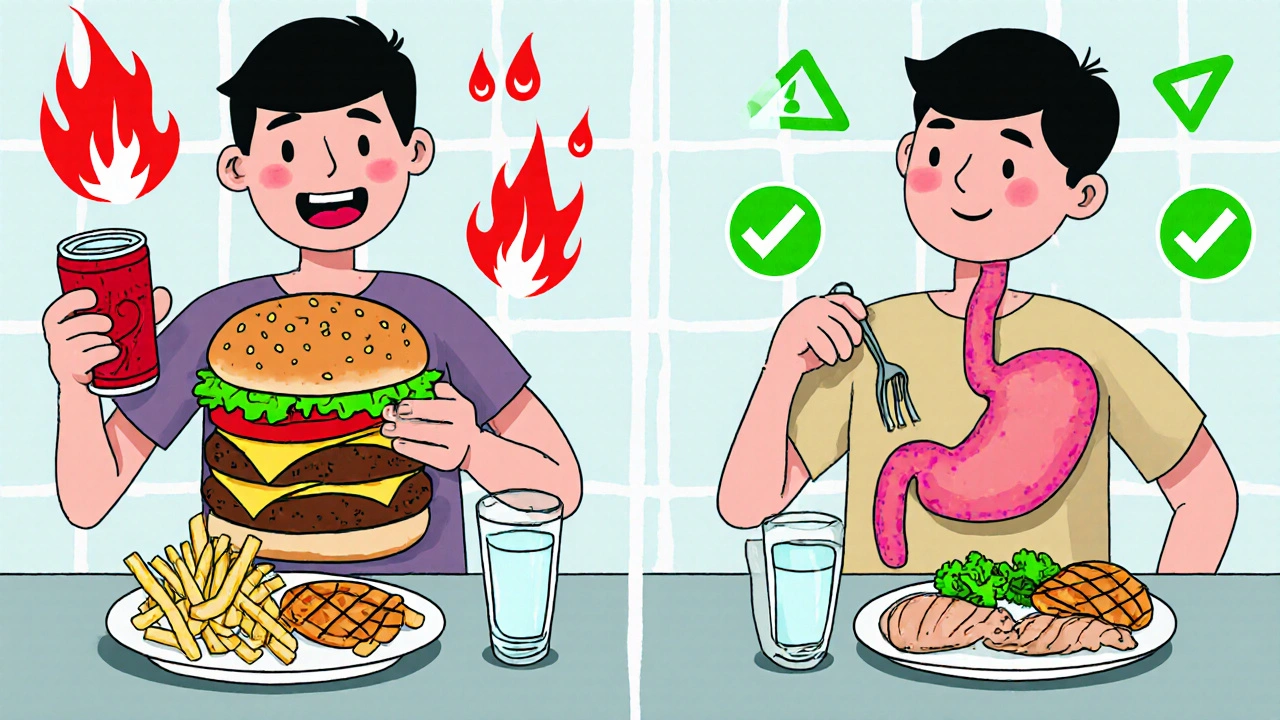
Medications: From Quick Fixes to Long-Term Control
When lifestyle changes aren’t enough, medications step in. They come in stages, and you don’t need to start with the strongest.Antacids like Tums (calcium carbonate) work fast-they neutralize acid in minutes. But their effect lasts only 30 to 60 minutes. Great for a quick fix after a big meal, but useless for all-day control.
H2 blockers like famotidine (Pepcid) reduce acid production by 60-70%. They kick in within an hour and last 10-12 hours. Many people use them for occasional heartburn or before eating a trigger meal. They’re safe for short-term use, but not strong enough for daily, severe reflux.
Proton pump inhibitors (PPIs) are the gold standard for moderate to severe GERD. Drugs like omeprazole (Prilosec), esomeprazole (Nexium), and pantoprazole (Protonix) cut acid production by 90-98%. They’re not instant-take them 30 to 60 minutes before your first meal of the day, and it takes 2-5 days to reach full effect. For erosive esophagitis (visible damage in the esophagus), PPIs heal it in 80-90% of cases within 8 weeks.
But long-term PPI use comes with risks. The FDA warns of increased chances of pneumonia, C. diff infection, kidney problems, and low magnesium levels after more than a year of use. If you’ve been on a PPI for over a year, ask your doctor about checking your magnesium levels every six months.
Enter vonoprazan (Voquezna), the newest player. Approved in late 2023 and expanded for long-term use in May 2024, it blocks acid more completely than PPIs. In studies, 95% of patients kept their stomach pH above 4 for the full 24 hours-compared to just 65% with PPIs. That’s huge for people who get nighttime reflux, which affects 70% of PPI users.
Surgery: When Pills Aren’t Enough
About 10-15% of people with GERD eventually need surgery. That’s not because they failed-it’s because their anatomy makes medical treatment less effective.The most common procedure is laparoscopic Nissen fundoplication. Surgeons wrap the top of the stomach around the lower esophagus to reinforce the LES. It works-90-95% of patients are symptom-free after five years. But about 15-20% develop gas-bloat syndrome (can’t burp, feel full fast) and 5-10% have trouble swallowing.
The LINX device is a newer option. It’s a small bracelet of magnetic titanium beads implanted around the LES. It lets food pass through normally but snaps shut to block acid. After five years, 85% of patients stay off daily PPIs. Only 2-3% need reoperation. The catch? You can’t get an MRI afterward, and it’s not recommended if you’ve had prior stomach surgery.
Transoral incisionless fundoplication (TIF) is another option-no cuts, done through the mouth with an endoscope. It’s less invasive but has a lower success rate (70-75% at three years) and only 127 doctors in the U.S. are trained to do it as of early 2025.
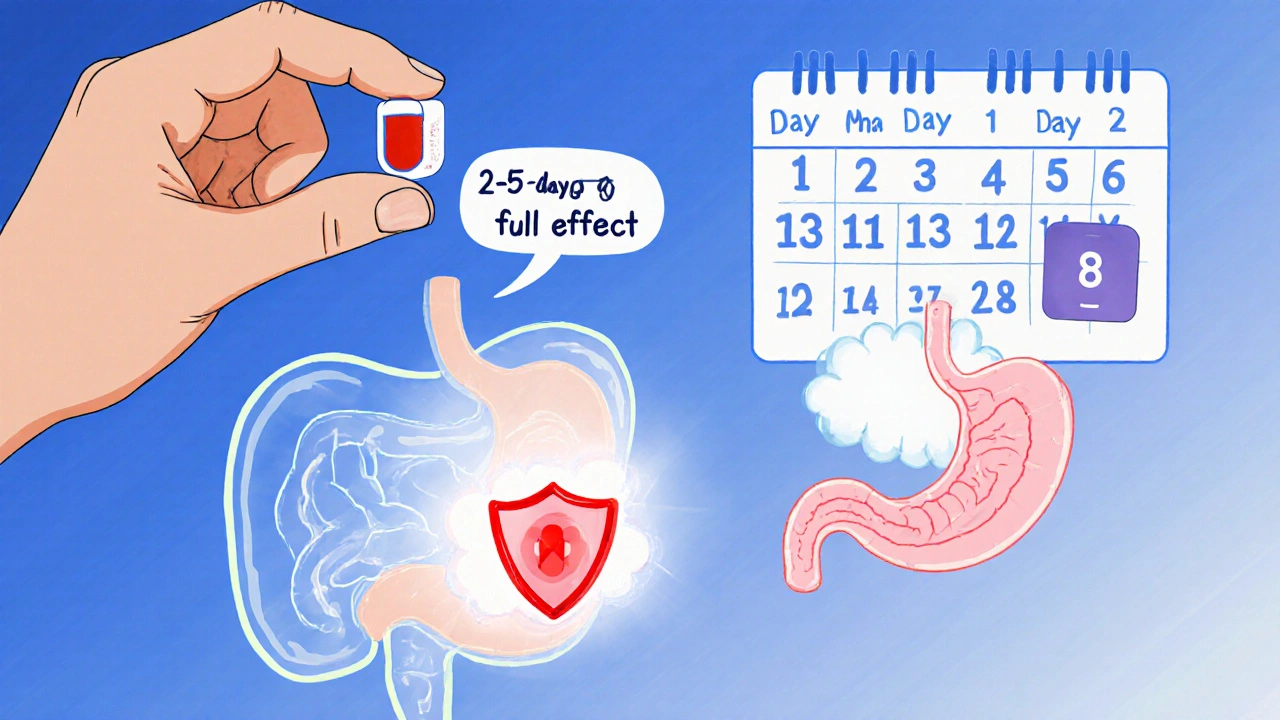
What Works for One Person Might Not Work for Another
There’s no one-size-fits-all fix. On Reddit’s r/GERD community, some users swear by a strict low-fat diet and bed elevation-no meds needed. Others tried PPIs for years, then switched to LINX and haven’t looked back.But many report side effects. Nearly 30% of Amazon reviews for omeprazole mention headaches. 19% say diarrhea. 12% report fatigue or tingling from low B12. Trustpilot ratings for LINX are mostly positive (78%), but 22% complain about trouble swallowing pills or ongoing bloating.
Doctors now know that not all GERD is caused by acid. Some people have normal acid levels but a hypersensitive esophagus. That’s why some patients still feel burning even after taking PPIs. For them, stress management, breathing exercises, or even cognitive behavioral therapy can help.
Diaphragmatic breathing-deep belly breaths taken slowly after meals-has been shown to reduce symptoms by 35% in mild cases. But only 30% of people stick with it long-term. It’s simple, free, and safe. Worth trying.
What’s Next for GERD Treatment?
The market for GERD meds hit $7.2 billion in 2023, with PPIs making up 65% of sales. But things are shifting. Newer drugs like vonoprazan are gaining ground. The LINX device sales are growing 12% a year. Obesity rates are rising-47% of U.S. adults are expected to be obese by 2030-which means more GERD cases.The American College of Gastroenterology is updating its guidelines in late 2025 to reflect new findings on non-acid reflux and personalized diets. That means your treatment plan should be tailored-not copied from someone else’s.
The bottom line? Start with lifestyle. Track your triggers. Use meds wisely. Don’t stay on PPIs longer than needed. And if you’re still struggling, talk to a specialist. Surgery isn’t a last resort-it’s a valid option for the right person.

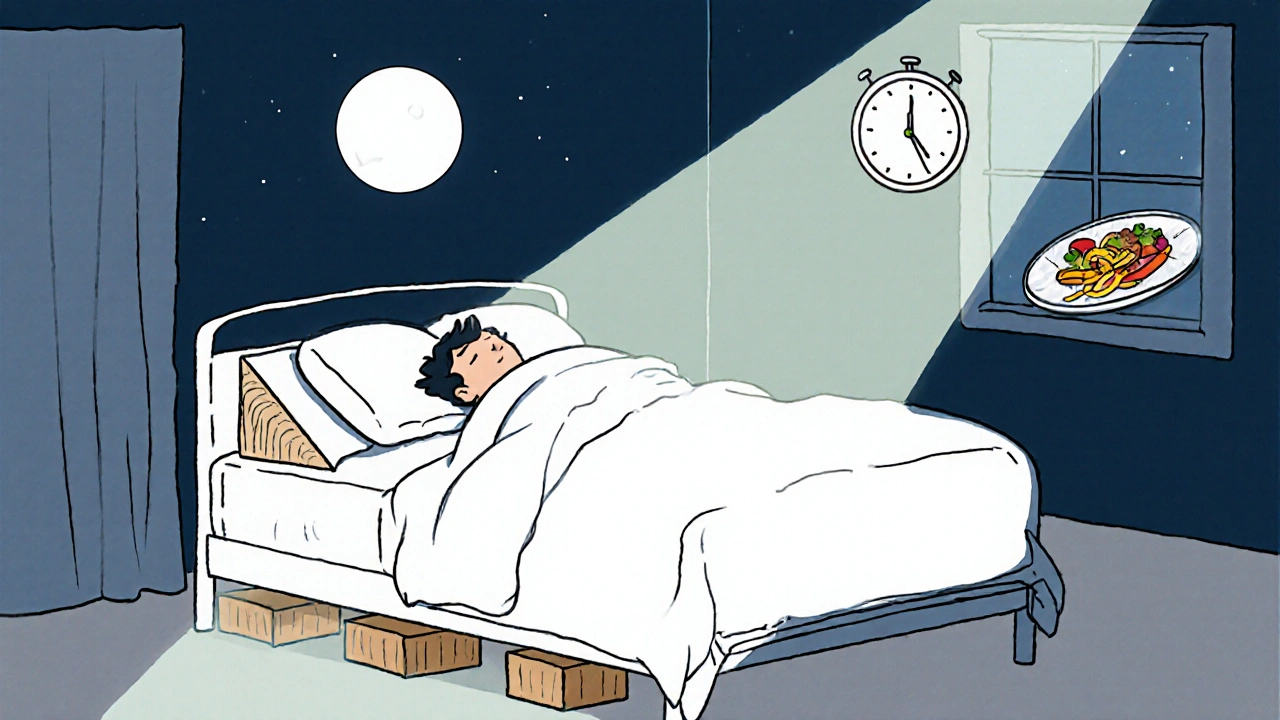
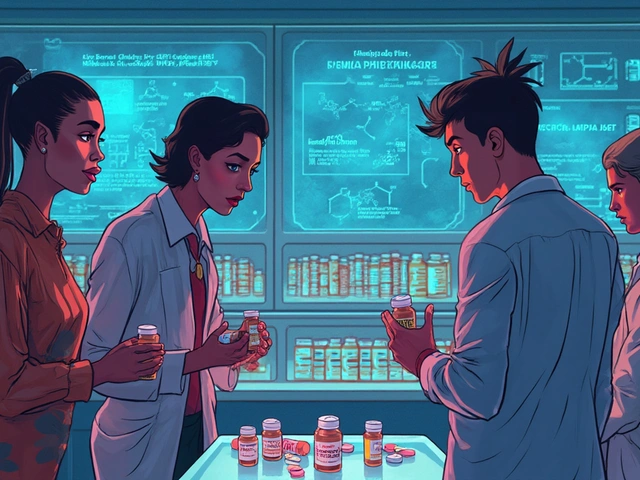
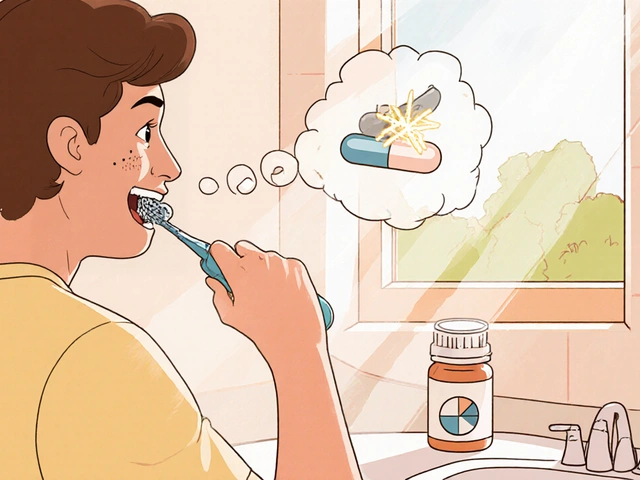
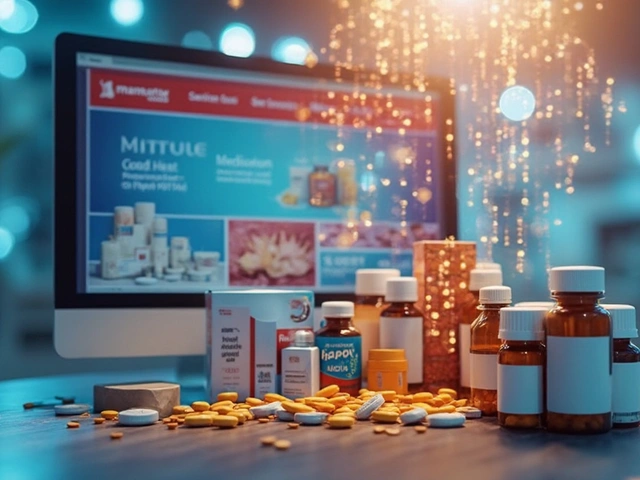
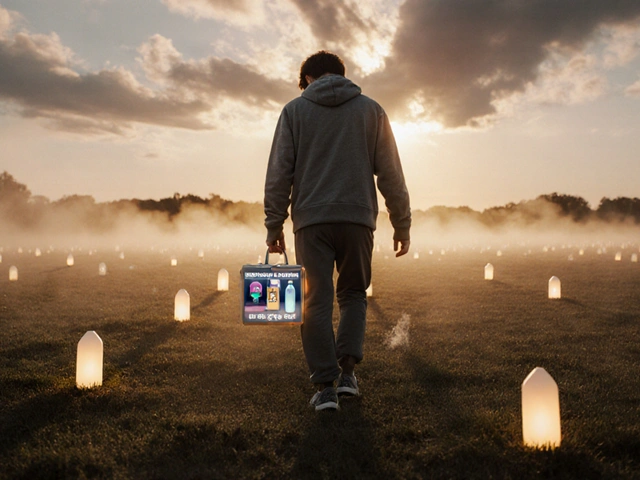
Nicole M
November 12, 2025 AT 21:17 PMI’ve been doing the bed elevation thing for 3 months now and honestly? It’s the only reason I can sleep without waking up choking on acid. No pills, no drama. Just blocks under the bed legs. Simple. Free. Works.
Alex Ramos
November 14, 2025 AT 19:36 PMSame. I used to take PPIs daily until I found out my reflux was worse after coffee and chocolate. Cut both, started walking after dinner, and boom-no more nighttime burns. Also, diaphragmatic breathing? I thought it was BS until I tried it. Now I do it after every meal. Feels like a reset button for my gut.
edgar popa
November 15, 2025 AT 00:59 AMlow fat diet changed my life. no more meds. just grilled chicken and rice. easy.
Arpita Shukla
November 16, 2025 AT 07:13 AMEveryone talks about food triggers but no one mentions that GERD can be linked to hiatal hernias. If you’ve tried everything and it’s still bad, get an endoscopy. I had a 3cm hernia and didn’t even know it. LINX fixed it. Also, don’t believe the myth that PPIs are harmless long-term. I got kidney damage from 5 years of omeprazole. Don’t be that person.
Mark Rutkowski
November 18, 2025 AT 06:59 AMThere’s a quiet revolution happening in GERD care. We’ve been treating symptoms like they’re the disease, when really, we’re ignoring the body’s signals-stress, posture, breathing, even how fast we chew. The esophagus isn’t broken; it’s overwhelmed. And maybe, just maybe, the real cure isn’t in a pill bottle but in learning to listen again. Not to the burn, but to the silence before it comes.
David Barry
November 19, 2025 AT 20:20 PMLet’s be real. 90% of these ‘lifestyle hacks’ are just middle-class people pretending they have control over biology. You think elevating your bed fixes GERD? Try working two jobs, eating takeout at 11pm, and sleeping on a couch. Your ‘6-inch wedge’ doesn’t help when your stomach’s already screaming from 12 hours of cortisol overload. Stop blaming the food. Blame the system.
Eve Miller
November 20, 2025 AT 15:55 PMActually, the article misstates the pH of tomatoes. Most ripe tomatoes are around pH 4.1–4.6, not 2.0. Citrus is lower, yes-but tomatoes aren’t ‘acidic’ in the way people think. The irritation comes from histamine and enzymatic activity, not pH. Also, ‘cooking tomatoes reduces acidity’ is misleading. It reduces volatile acids but not titratable acidity. Please, people, stop spreading nutrition myths.
Ryan Everhart
November 21, 2025 AT 05:45 AMso you’re telling me i need to stop drinking beer, eat salad for dinner, and breathe like a yoga instructor just to not feel like i’m swallowing lava? cool. got it. meanwhile my ppi is on auto-ship and i’m not even mad.
Shante Ajadeen
November 22, 2025 AT 08:23 AMMy mom had GERD for 20 years. She tried everything. Then she started sleeping on her left side. Not the right side. Left. Changed everything. No one talks about that. Just try it. No cost. No risk. Worth a shot.
manish kumar
November 24, 2025 AT 01:58 AMI’ve been managing GERD for over a decade, and I can tell you this: the real game-changer isn’t the medication or the wedge pillow-it’s consistency. You can’t do the diet for a week and expect miracles. You have to treat it like brushing your teeth. Every. Single. Day. I stopped eating after 7 p.m., cut out caffeine after noon, started walking 20 minutes after dinner, and yes, I sleep with my head elevated. It’s not glamorous. It’s not trendy. But after five years of this, I haven’t taken a PPI in three. And I didn’t need surgery. Just discipline. And maybe a little stubbornness.
Danae Miley
November 25, 2025 AT 06:12 AMRegarding vonoprazan: the FDA’s approval for long-term use was based on a 12-month trial with 1,200 patients. That’s not long-term. That’s medium-term. We have zero data on 5+ year outcomes. Also, the 95% pH control claim? That’s in healthy volunteers, not patients with erosive esophagitis. Please stop hyping this as a miracle drug. It’s promising, yes-but not a panacea.
Charles Lewis
November 26, 2025 AT 18:48 PMAs a gastroenterologist with over 25 years of clinical experience, I want to emphasize that GERD is not a single disease. It’s a spectrum: erosive, non-erosive, hypersensitive, and functional reflux. Many patients are misdiagnosed because their endoscopy looks normal, so they’re told it’s ‘just stress.’ But the esophagus is still being damaged-just not visibly. We need more nuanced diagnostic tools, like impedance-pH monitoring, not just symptom checklists. And yes, vonoprazan is a breakthrough-but only for acid-dominant cases. For non-acid reflux, we still have very few options.
Alyssa Lopez
November 28, 2025 AT 06:39 AMU.S. citizens need to stop coddling their guts. If you can’t handle a burger and a beer without crying, maybe you shouldn’t be eating them. GERD is a first-world problem caused by people who think they’re entitled to comfort 24/7. Get off your couch. Move. Eat less. Stop whining. We have real health crises in this country-this is just people being lazy.
dace yates
November 28, 2025 AT 12:10 PMHas anyone tried the low-FODMAP diet for GERD? I read a study that said 60% of non-erosive GERD patients improved on it. Not because of acid, but because of gas and bloating pushing up on the LES. I cut out onions, garlic, and apples-and my nighttime reflux dropped 80%. Nobody talks about this. Just saying.
Renee Ruth
November 30, 2025 AT 11:44 AMI’ve been on PPIs for 7 years. I got osteoporosis, lost my B12, and now I have chronic fatigue. My doctor said it’s ‘probably unrelated.’ I’m not buying it. I’m not a number. I’m not a statistic. I’m the person they forgot to warn. And now I’m stuck. My insurance won’t cover LINX. My surgeon says I’m ‘too young’ for surgery. So what now? Just keep taking the poison until I die? This system is broken.